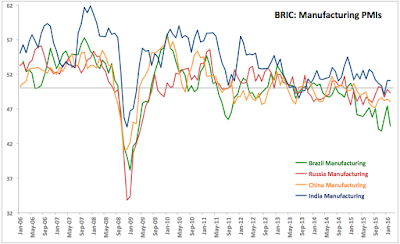Earlier this week, I posted on the latest PMI reports for BRIC economies for Manufacturing sector (https://trueeconomics.blogspot.com/2021/04/5421-brics-manufacturing-pmis-1q-2021.html). Now, let's cover Services Sector 1Q 2021 PMIs. Remember, Markit - source of data - cover only monthly PMIs.
As reminder, Manufacturing PMIs fell in all BRIC economies except for Russia in 1Q 2021 compared to 4Q 2020. As the result, overall, BRIC Manufacturing Activity Index (GDP-weighted average of PMIs) fell from 54.8 to 52.8 between 4Q 2020 and 1Q 2021.
In services sector:
- Brazil Services PMI slipped into a recessionary territory in 1Q 2021, falling from 4Q 2020 reading of 51.4 to 46.1 in 1Q 20201. This marks the lowest reading since 2Q 2020.
- Russia Services PMI rebounded robustly from 4Q 2020 reading of 47.7 to 1Q 2021 reading of 53.6. Russian Services PMIs have been very volatile during the pandemic period, hitting the low of 32.0 in 2Q 2020 and the high of 56.8 in 3Q 2020.
- India Services PMI improved from growth-signaling 53.4 in 4Q 2020 to even faster growth-consistent 54.2 in 1Q 2021. India and Russia were the two BRIC economies posting improvements in services sector in 1Q 2021.
- China Services PMI fell from 'very high growth' signaling reading of 57.0 in 4Q 2020 to moderate growth-signaling 52.6 in 1Q 2021.
- Overall, BRIC Services Sector Activity Index - a measure I calculate based on Markit PMI data inputs - fell from 54.8 in. 4Q 2020 to 52.6 in 1Q 2021, virtually matching the decline in Manufacturing Sector Activity Index over the same period of time.
- BRIC Services Activity Index also underperformed Global Services PMI which average 53.3 in 1Q 2021. In 4Q 2020, BRIC Services Activity Index was ahead of Global Services PMI (54.8 to 52.3).





































